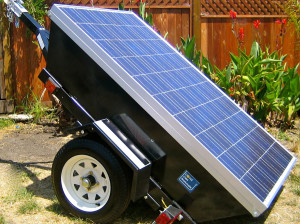Solar Power System is a mechanism that is can be placed on the building’s roof or on the land, that produces electricity.
The amount of solar energy reaching the surface of the planet is so vast that in one year it is about twice as much as will ever be obtained from all of the Earth’s non-renewable resources of coal, oil, natural gas, and mined uranium combined.
Solar power is the conversion of sunlight into electricity, either directly using photovoltaics (PV), or indirectly using concentrated solar power (CSP). CSP systems use lenses or mirrors and tracking systems to focus a large area of sunlight into a small beam. PV converts light into electric current using the photoelectric effect.
Solar power systems generate electricity at peak power usage times (during the day) when the value and cost of electricity is the highest. Modern grid-tied home solar power systems can use the cheap rate grid power at night and reduce or eliminate the need for the high rate electrical power during the day. Home-owners can actually push power back into the electrical grid during the day and run their meters backwards which is generates energy credits and even capital. Imagine your electric company sending you a check every month instead of a bill!
We will show the advantages of solar energy producing for home or business purpose the example of Greece.
Greece ranks 5th worldwide with regard to per capita installed PV capacity. 4.5 billion € were invested in PV in Greece during the last 5 years. In 2016, PV is expected to cover 10% of electricity demand in Greece.
The operators of the PV or solar energy installations whose capacity does not exceed 1 MWp do not require a licence.
Procedure:
- The transmission grid operator, the Greek Electricity Market Operator and the plant operator conclude a contract
- The plant is connected to the grid
- The transmission grid operator measures the amount of electricity the plant operator exports to the grid
- The plant operator issues an invoice to claim payment of the feed-in tariff
- The transmission grid operator and the Greek Electricity Market Operator shall pay the tariff within 20 days
Feed-in tariff II (PV on rooftops) scheme. The scheme applies to private individuals and small enterprises.
Roof-mounted PV installations of up to10kW on the mainland and roof-top off-grid installation of up to 5 kW.
The scheme supports electricity generation by roof-top PV installations of up to 10 kWp through a guaranteed feed-in tariff. This tariff is first deducted from an installation operator’s electricity charges as indicated on his electricity bill. If the tariff exceeds the installation operator’s electricity bill, he will receive the exceeding amount. The tariff is € 495 per MWh. In Crete such a mechanism produces in 1KW system power around 1450 Kwh per year. So for every installed power system of 1KW we have an annual income around 700€ and for a 10KW we reach the 7.000€ per year especially in Crete because its latitude. At the moment this latitude is one of the best in Europe in the utilization of solar energy.
Procedure.
- Installation operators are contractually entitled against the national energy supplier to the payment of the statutory feed-in tariff for electricity supplied to the grid. The grid operator is obliged to enter into these contracts.
- The national energy supplier measures the electricity exported to the grid. He sends the electricity bill to the plant operators. If the feed-in tariff for the electricity produced exceeds a plant operator’s electricity charges, the national supplier shall pay the difference.
Feed-in-tariffs are guaranteed for 20 years, and they range from 0.4 to 0.5 €/kWh (adjusted annually for inflation and/or increases in retail electricity prices). You continue to buy power from the PPC and to pay the price you pay now (0,10 – 0,12 €/ kWh).
The citizen-investor trader is, in other words not obliged to open records to the tax office. As stated in the ministerial decision, “there are for the main photovoltaic system no tax liabilities for the release of this energy network”. In other words, any income you get from the sale of energy is not taxed.
Furthermore, commercial applications are eligible to grants (30-55% of total system cost), while small domestic applications are eligible for a 20% tax deduction capped at € 500 per system.
Investments in Solar Power System
Solar unit has fallen significantly in recent years, costs between 7,000€ and 10,000€ for 4kWp system.
Expenses
Once installed, the panels will require little maintenance but need to be kept clean and free from any debris from nearby trees. The panels should last 25 years or more but the inverter – which links your roof to your domestic supply – is likely to need replacing at some point and will set you back around 800€ currently.
Income
As mentioned above, you can have income about 700€ for every installed power system of 1KW. So, if you have 4kWp power system you will get about 2,800€ a year.
Payable
It will be about 4 years to get a return on the investment in the Solar Power System.
The UK Example
Feed-in tariff is 14.38p and every kWh your system generates that you don’t use in your home will earn you 4.64p, meaning a typical home with a 4kWp system could make a combined saving of around £750 a year.
We can conduct the project estimating in another interesting for you area and country to find out if it is effective for implementation.


